“Nighthawks” Edward Hopper – The Lonely Diner at Night
Imagine you are standing on a city street corner, late at night. You peer into the window of a diner and see four people inside. Maybe you feel less alone knowing there are other night owls out there, or in this case, Nighthawks. This is the title of the painting by the American realist artist Edward Hopper, which we will discuss in this article.
Artist Abstract: Who Was Edward Hopper?
Edward Hopper was born in 1882 in a town called Nyack in New York, United States. He was artistically inclined from a young age, around five years old. He started drawing sketches and in his teenage years, and used mixed media like oil paints, charcoal, pen-and-ink, and watercolors. He was a student at the New York School of Art and Design.
His art teachers included William Merritt Chase, who also inspired Hopper’s earlier art style. Hopper was also inspired by the styles of Édouard Manet and Edgar Degas, all figures from the French Impressionism art movement. Hopper married Josephine Nivison in 1924 who made a significant impact on his work and life.

Nighthawks by Edward Hopper in Context
Known as one of the more popular, and widely reproduced, American oil paintings from the Modern 20th-century art is Nighthawks (1942) by Edward Hopper. Often described as a “timeless” painting, it depicts an every day – or every night – scene of four people in a diner. This is something almost everyone can relate to, but this painting touches on deeper meanings than a diner countertop.
In this article we will explore a brief contextual analysis, we will provide some historical context of how this work is part of the American Realism movement and what may have influenced Hopper to paint it.
Next, we will look at a formal analysis and Hopper’s artistic style in this painting, for example, the way he utilized color to depict light and dark, his use of line, and of course, the subject matter – just what are we looking at when we see four people sitting in a diner in New York City? Below we look at all these and more.
| Artist | Edward Hopper |
| Date Painted | 1942 |
| Medium | Oil on canvas |
| Genre | Genre painting |
| Period / Movement | American Realism, Social Realism |
| Dimensions | 84.1 x 152.4 centimeters |
| Series / Versions | Not applicable |
| Where Is It housed? | Art Institute of Chicago |
| What It Is Worth | Sold in 1942 for $3000 |
Contextual Analysis: A Brief Socio-Historical Overview
If we look at the year and location that Edward Hopper painted Nighthawks, which was 1942 in America, specifically New York as this was where the artist lived, we will find it gives us more contextual analysis about the impact of this painting. Keep all these points in mind before we look at this famous diner painting.
World War II was in full swing during 1942 and 1941 was the year when Japan bombed Pearl Harbor. To prevent aircraft bombings American cities also practiced blackout drills, which consisted of cities dimming or switching off most of their lights to minimize the extent of becoming a target.
This time undoubtedly impacted all Americans and left them feeling a sense of uncertainty and fear about their lives and the outcome of the War.
Although this was not the sole reason for why Edward Hopper painted Nighthawks, it is an important consideration to bear in mind when looking at his painting as it is depicted with a sense of quiet, dimness, and eeriness that can easily be attested to the prevalent mood of that time, which was undoubtedly one of foreboding.
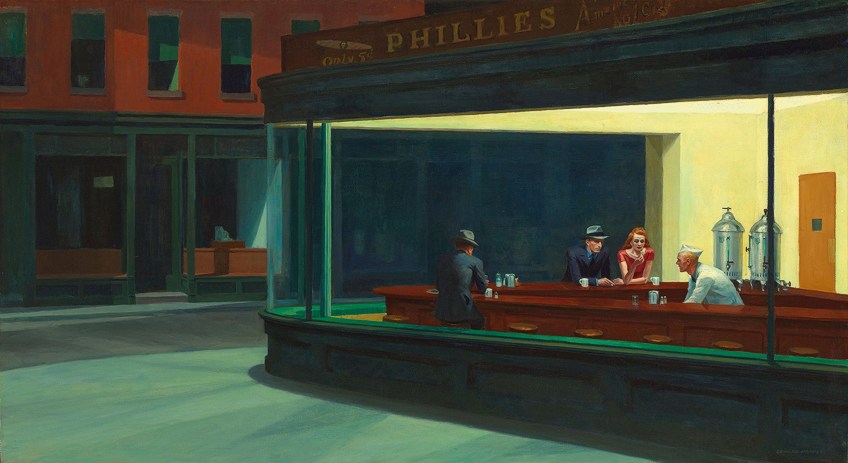
New York during the 1940s was a bustling city full of life and development. The urbanized city life in New York was also a common way of life with thousands of people living in neighborhoods and apartment blocks going about their business. We cannot help but wonder what peoples’ lives were like during the 1940s – was it like today?
If anything, we can estimate that living in a big city like New York had, and still has, its upsides and downsides whether you are alone or not. What was the existential quality for an inhabitant of New York, especially someone who lived during a time of rapid modernization in culture and technology?
A Bit More About Hopper
Hopper was born and grew up in the small village of Nyack in New York and moved to Greenwich Village in New York City in 1913 where he stayed for the remainder of his life. He worked as an illustrator for a large part of his career in New York City and sold his first painting titled Sailing (1911) in 1913 at the Armory Show in New York; he only sold other paintings years later.
He made three trips to Europe before he settled in Greenwich Village and slowly developed his career as an artist. He visited cities like Paris and Amsterdam and experienced what art was like there.
During his time in Paris, Hopper was notably influenced by the Impressionists, namely by artists like Édouard Manet, Edgar Degas, Pierre-Auguste Renoir, Camille Pissarro, among others and how they painted scenes of modern life living in the city. Hopper also reportedly painted street scenes during his visits in Paris, a style called en plein air, which means “in the open air”; he also painted from live models.
Hopper was also moved by Rembrandt van Rijn’s The Night Watch (1642) housed in the Rijksmuseum in Amsterdam. Hopper is reported to have said the following about Rembrandt’s The Night Watch painting: “[it is the] most wonderful thing of his I have seen, its past belief in its reality – it almost amounts to deception”.

Hopper loved his time in Paris and considered it one of the most beautiful cities in the world. He also considered himself an Impressionist throughout his career. Although he has primarily been categorized as an American Realist painter, he was also drawn to the realist genre of painting.
Hopper was also influenced by Charles Meryon, who was a famous French engraver and well-known for his Gothic style of etches of Paris.
Hopper’s painting process was apparently very slow, and it took him considerable time to find the right subject matter. He is also reported to have stated that his painting “crystalized” when he started printmaking in 1915. His etchings were notably mysterious in their mood, a good example of this is his Night Shadows (1921), which depicts an aerial view of a solitary figure walking on a street corner in New York.
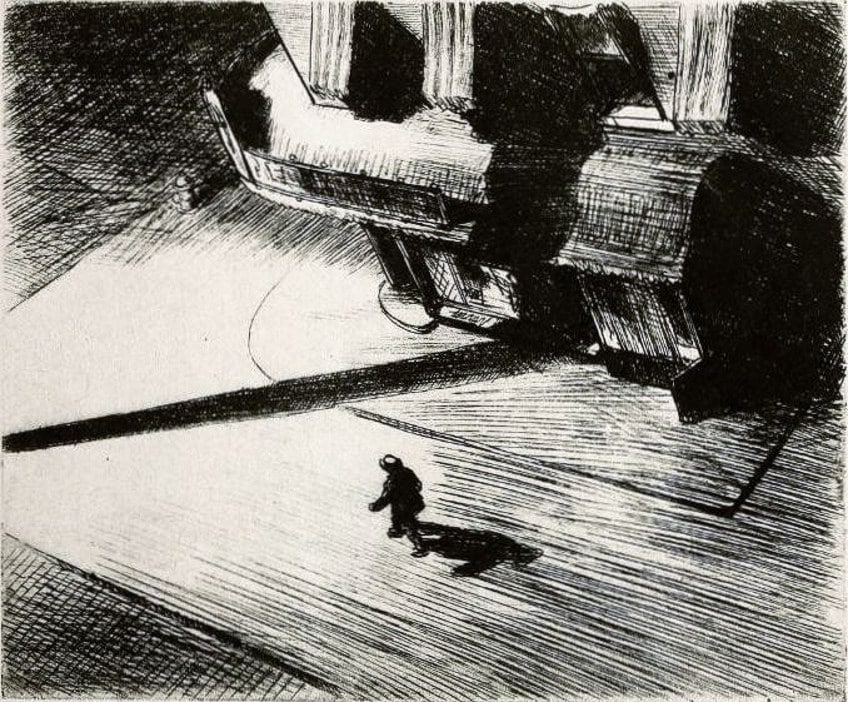
This shadowy-based style was also influenced by film noir during the 1940s. Films and theatre were important parts of Hopper’s life and ultimately his art style. He loved watching films and visiting theatres, in fact, his teacher from the Ashcan School, Robert Henri, motivated him to do this to also observe life and people around him.
Hopper is reported to have said, “When I don’t feel in the mood for painting, I go to the movies for a week or more. I go on a regular movie binge”.
It was in 1923 when Hopper and Josephine Nivison met each other again, previously they met through Robert Henri as students. The two ended up marrying in 1924 and would be together for the rest of their lives.
During the 1930s Hopper’s artistic career started flourishing, he sold around 30 paintings and around 18 watercolors to prominent art museums like the Metropolitan Museum of Art and the Whitney Museum of American Art. The Museum of Modern Art exhibited a retrospective of Hopper’s work during 1933 after accessioning his painting House by the Railroad (1925) as part of their permanent collection in 1930.
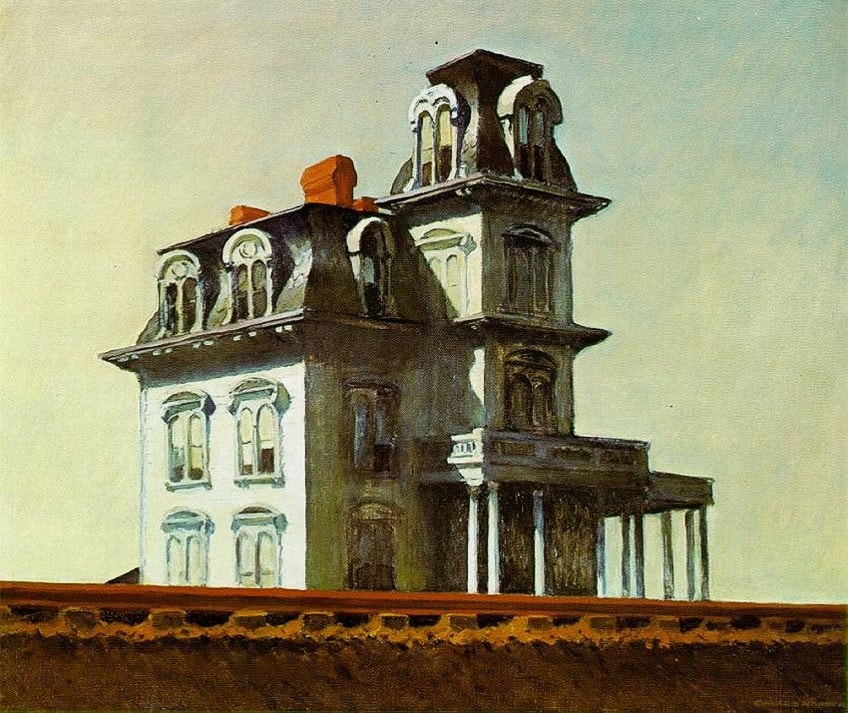
Hopper certainly received artistic recognition and acclaim during the 1930s all the way to the 1960s from the years of struggle and seemingly uneventful artistic career. He continued to create paintings with the characteristic theme of solitary figures amidst various urban landscapes, often with an open-ended narrative, leaving it up to us, his viewers, to determine the outcome of his painted characters.
Jo and Edward are described as having lived a “frugal” lifestyle and would spend their money on movie or theatre tickets and eating out at inexpensive diners. The couple also traveled to various places like New England where they would stay and paint, including their house in South Truro in Massachusetts.
The couple was known to have a difficult relationship, but, nonetheless, Jo was Hopper’s model for his paintings and gave his artistic career a boost in many ways. Hopper was also known as an introvert and did not find social aspects of life easy to handle. He lived very inwardly, a lover of art in all forms, painting, literature, and film.
He was a conscientious artist, and, with Jo’s input, his paintings were extensively planned before their execution, much like the delicate planning that goes into directing a movie.
Formal Analysis: A Brief Compositional Overview
Below we zoom in on Hopper’s acclaimed painting Nighthawks (1942). We will explore its subject matter and some of the stylistic elements Hopper employed in its creation, particularly his use of lighting and perspective.
Subject Matter
In Hopper’s Nighthawks painting we see a diner with four people inside, on what appears to be a street corner. There are three men and one woman, of which Hopper and his wife Jo were the main models. Surrounding the diner are other apartment buildings reminiscent of a street in New York City. The scene takes place during the night with no other sign of life other than the four figures inside.
Although this scene appears very simplified and solitary, there are detailed props and cues that give us a scene filled with life.
Let us start with the diner. There is no door indicated for the diner, the only door we see is the one inside that appears to be the kitchen door. The windows almost become an enclosed frame for the four figures inside, leading our attention to them. Furthermore, the diner is the only source of light also lighting up the pavement outside, further highlighting the figures inside.
Above the diner, we see an advertisement, or possibly the name of the diner, that says, “Only 5c Phillies”. The remainder of the advertisement words are partially cut off by the composition, but it appears to read “America’s No 1 Cigar”.

The Four Night Hawks
There are four figures inside, three sit around the wooden countertop, which takes up most of the space inside the diner and appears almost triangular in its shape. The waitron, who wears a white uniform and hat, is on the inside of this space, behind the counter. He is looking ahead at something with his mouth partially open in a grimace of some sort busy with something behind the counter.
He is the only figure out of the four with a more animated facial expression.
There are two figures sitting next to each other on the other side of the counter opposite the waitron. From our view, the woman sits on the right and the man is next to her (our left). She has reddish-brown colored hair, wears a red blouse, and holds up what is possibly a sandwich in her right hand (our left). The man next to her wears a steel gray hat with a navy suit and tie, a light blue shirt underneath, and a cigarette in his right hand (our left), his hands resting on the countertop.
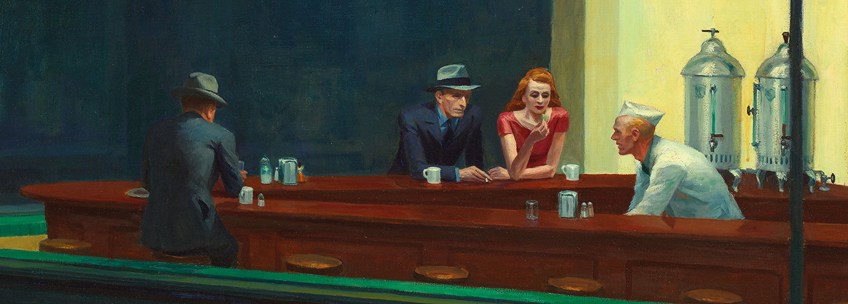
Although these two figures are sitting closely next to one another they appear to be worlds apart. Their left hands (our right) are both resting on the countertop and at first glance, it would appear they are touching, but if you look closer, there is no intention for their hands to connect despite the physical closeness; both appear deep in thought or maybe just a general malaise?
The other figure sits on the other side of the counter with his back to us. All we know about this figure is that he wears a similar hat to the other man and a dark-colored suit. He holds a glass in his right hand and there appears to be a folded newspaper resting under his left elbow. He sits on the second bar stool from the outer edge of the counter; there are seven bar stools along the counter.
The Props
The diner seems to be the main focal point of the Nighthawks painting, but it would somehow not have the same impact without the props surrounding the four figures. If we look at the countertop, we see the meticulous attention to detail in the coffee cups, glasses, napkin holder, and salt and pepper shakers.
There is also an extra glass near the fifth stool of the counter – who does this belong to?
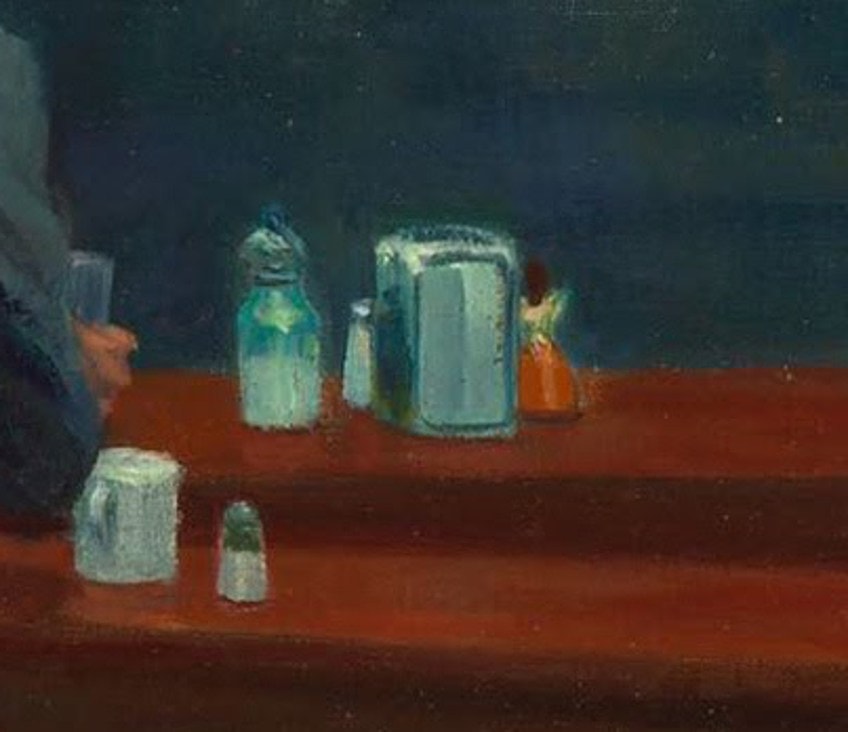
Near the kitchen door to the far-left corner inside the diner, the only corner we can visibly see inside the diner, we also notice two large silver coffee urns including how much coffee is in each; the left urn appears to be on empty and the right urn has about a third of coffee left in it.

The setting outside the diner is darker, the interior spaces below and above in the building across the street are all closed indicating no light or life. All we see through the windows inside the space below is a cash register on a wooden counter, suggesting it is a shop. Above, the forest-green blinds of the vertical-rectangular windows appear half shut.
Color and Light
Edward Hopper utilizes color to depict ambient light in the Nighthawks painting, we see this primarily in the fluorescent light in the diner, which was a popular and new type of light form during the 1940s. This light seemingly works like a spotlight on the central figures, almost as if it is a light on a theatre stage highlighting the main characters.
The yellow ceiling makes the light just a little warmer.
Furthermore, if we zoom in on the figures’ skin tones, we see the effects of the light, which gives them a “washed out” look. The light moves onto the pavement outside, illuminating the surrounding area, but as we move further into the street, it becomes darker suggesting more lifelessness around the diner.

Additionally, we do not see any other form of light other than the diner light, which also reaches its way into the shop across the street and some of the windows above it. Hopper depicted light in a realistic manner – this is something we would see if we were standing on a darkened street corner looking in on an illuminated diner.
Depicting light was one of Hopper’s goals and loves. We see this not only in the way he depicts artificial man-made light but sunlight too in many of his other paintings. Some include Rooms by the Sea (1951), Morning Sun (1952), and Second Story Sunlight (1960), among others.
He is remembered as saying, “I guess I’m not very human. All I really want to do is paint light on the side of a house”.

Perspective
The way Hopper utilized perspective in his Nighthawks painting is significantly interesting and artistically astute. He created numerous preparatory sketches not only for the characters and props but also for the compositional layout and perspective. As noted earlier, the countertop inside the diner appears like a triangular shape, which echoes the triangularity of the street corner the diner is located on.
The entire diner is also viewed from an angle through the perspective of an unknown viewer, which is presumably us; there is an element of voyeurism in the way Hopper depicted the Nighthawks scene. Furthermore, Hopper utilized the placement of horizontal and vertical lines to create a focal point, which is the diner.
If we look at the diner to the right side of the composition, the horizontal lines from the top and bottom of the structure converge to a focal point somewhere in the distance to the left that we cannot see.
A Question Left Unanswered
The Nighthawks’ painting value around 1942, the year it was sold to the Art Institute of Chicago, was $3000. It was reportedly sold a few months after it was completed in January of the same year. Hopper stated that the diner painting was “suggested by a restaurant on Greenwich Avenue where two streets meet”, however, this diner has been widely searched for as a location.
Furthermore, this famous diner painting has been the inspiration for modern-day pop culture, from movies, literature, paintings, and many other artistic modalities. For example popular TV series like The Simpsons, CSI: Crime Scene Investigation, Joyce Carol Oates’ poem titled Edward Hopper’s Nighthawks, 1942, the music album titled Nighthawks at the Diner (1975) by Tom Waits, and many others.

The main “buzz words” around this painting include timelessness and loneliness because it shows us the realities of living in a city brimming with culture and people, yet the other side of it can leave one feeling completely isolated in its throes. Hopper ironically did not solely aim to depict this aspect; he was reported as saying, “unconsciously, probably, I was painting the loneliness of a large city”. We can believe this as he lived in the city and must have felt similar feelings.
Hopper depicted a scene so empty that it was filled with potential, this potential has been explored by so many in the form of figuring out what the scene means and creating stories for the four characters. There have been many attempts at answering the inevitable questions that accompany this painting, namely, who are the people in this painting, where do they come from, and where are they going? A question Hopper left unanswered – a question he left on the table for us to answer.
Take a look at our Nighthawks painting webstory here!
Frequently Asked Questions
Why Is the Painting Called Nighthawks?
Nighthawks by Edward Hopper was given its name because of the sharp shape of the man’s nose sitting next to the woman. His nose resembles that of a bird’s beak, and it was suggested by Jo Hopper (Edward Hopper’s wife) that “Nighthawks” would be a good name for the painting.
What Is the Nighthawks Painting Value?
The Nighthawks painting value was $3000 in 1942, the year it was sold to the Art Institute of Chicago for the above price and only a few months after its completion. However, the value of this painting has undoubtedly increased since the 1940s.
Is the Nighthawks Painting Based on a Real Place?
A widely searched diner, Hopper stated that the diner painting was “suggested by a restaurant on Greenwich Avenue where two streets meet”. However, it is believed that this diner was based on various diners.
Alicia du Plessis is a multidisciplinary writer. She completed her Bachelor of Arts degree, majoring in Art History and Classical Civilization, as well as two Honors, namely, in Art History and Education and Development, at the University of KwaZulu-Natal, South Africa. For her main Honors project in Art History, she explored perceptions of the San Bushmen’s identity and the concept of the “Other”. She has also looked at the use of photography in art and how it has been used to portray people’s lives.
Alicia’s other areas of interest in Art History include the process of writing about Art History and how to analyze paintings. Some of her favorite art movements include Impressionism and German Expressionism. She is yet to complete her Masters in Art History (she would like to do this abroad in Europe) having given it some time to first develop more professional experience with the interest to one day lecture it too.
Alicia has been working for artincontext.com since 2021 as an author and art history expert. She has specialized in painting analysis and is covering most of our painting analysis.
Learn more about Alicia du Plessis and the Art in Context Team.
Cite this Article
Alicia, du Plessis, ““Nighthawks” Edward Hopper – The Lonely Diner at Night.” Art in Context. October 7, 2021. URL: https://artincontext.org/nighthawks-edward-hopper/
du Plessis, A. (2021, 7 October). “Nighthawks” Edward Hopper – The Lonely Diner at Night. Art in Context. https://artincontext.org/nighthawks-edward-hopper/
du Plessis, Alicia. ““Nighthawks” Edward Hopper – The Lonely Diner at Night.” Art in Context, October 7, 2021. https://artincontext.org/nighthawks-edward-hopper/.











